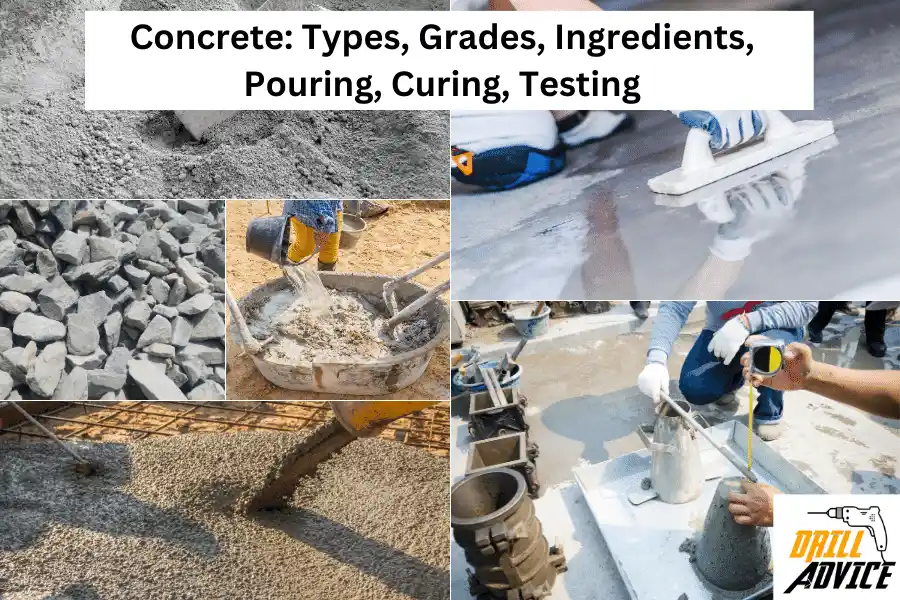
Concrete is a composite material that mainly consists of cement, aggregate, and water. The most important physical attribute of concrete is its higher density, higher compressive strength, long durability, and minimum thermal expansion. Solid concrete does not react with water. Therefore concrete is used to bear higher statics and dynamics loads in the structures in any environmental condition.
Mainly concrete has 7 types. Those types are plain or ordinary concrete, reinforcement concrete, prestressed concrete, high-performance concrete, lightweight concrete, high-density concrete and air-entrained concrete. Each of these types has various physical and chemical properties. General use concrete have 7 grades. These grades are M5, M7.5, M10, M15, M20, M25, and M30. More than M30 is considered as high strength concrete. M5 to M30 grade concrete can be mixed without a concrete mix design. More than M30 grade need a specific concrete mix design.
The main composition of the concrete is cement. Cement is a binding agent for concrete between coarse aggregates and fine aggregates. Mainly 5 different types of cement is available for various tasks. Those are OPC, PSC, PPC, quick-setting cement, and low-heat cement. Aggregates for concrete are mainly two types. Those are coarse aggregate and fine aggregates. Coarse aggregate is stones (granite) and fine aggregates are sand. For the higher compressive strength, need larger aggregates such as 1.5 inches and general residential use 3/4 inches aggregates.
Admixtures are used to improve the strength durability, control setting time, control water content, and control the corrosion of the reinforcement and reduce the shrinkage. Reinforcement of the concrete are used for the tensile strength of the concrete.
When concrete is used for domestic purposes, it can be mixed with hand and for a large amount can be mixed with using mixtures. The volume of the concrete is the multiplication of length, width and height. 3%-5% should be added to the final volume of the concrete for the wastage during the transporting. Concrete mix design is a standard method to prepare the concrete mixture according to international standards such as ACI 211.1 and BS EN 206.
The compressive strength of concrete is very important when it uses. The concrete is mainly tested for compressive strength. But other concrete tests are used to measure workability, permeability, and tensile strength mainly. If the concrete fails all test it should be demolished for safety. Concrete curing is applying water to the poured concrete to continue the hardening of the concrete and control the temperature and prevent cracks. Cracks, honeycombs, and chips, are the main defect of the concrete, and it can be fixed using curing, or applying a suitable sealant.
Defects can be prevented by using a quality concrete mixture, proper curing, and not exposure to harmful environmental conditions before hardening.
Concrete has a longer evaluation since 25BC. In 1849 this valuable material was found by Joseph Aspdin.
What are The Properties of Concrete?
Concrete Definition: Concrete is a composite material that mainly consists of cement, aggregate, and water. Concrete includes cementitious materials such as fly ash and slag cement in order to use as a filler and to improve the strength of the concrete. Admixtures are used in concrete to control the water content, workability and setting time.
The properties of concrete are mainly 2 types. Those are physical properties and chemical properties.
Physical properties of concrete
Physical properties of concrete is a characteristics or attribute of matter that can be observed or measured without altering the substance’s chemical composition.
| Physical Properties | Typical Values |
|---|---|
| Density | 2200 – 2500 kg/m³ |
| Compressive Strength | 20 – 60 MPa (varied with concrete grade) |
| Tensile Strength | 2 – 5 MPa |
| Durability | More than 100 year |
| Porosity | 8 – 15% |
| Thermal Expansion | 10 – 14 µm/m°C |
Chemical properties of concrete
Chemical properties of concrete are chemical reactions or interactions with other substances, resulting in a change in its chemical composition.
| Chemical Reaction | End Product |
|---|---|
| Tricalcium Silicate + Water | Calcium Silicate Hydrate + Calcium Hydroxide |
| Dicalcium Silicate + Water | Calcium Silicate Hydrate + Calcium Hydroxide |
| Tricalcium Aluminate + Water | Calcium Aluminate Hydrate |
| Tetracalcium Aluminoferrite + Water | Calcium Aluminoferrite Hydrate |
What are the 7 Types of Concrete?
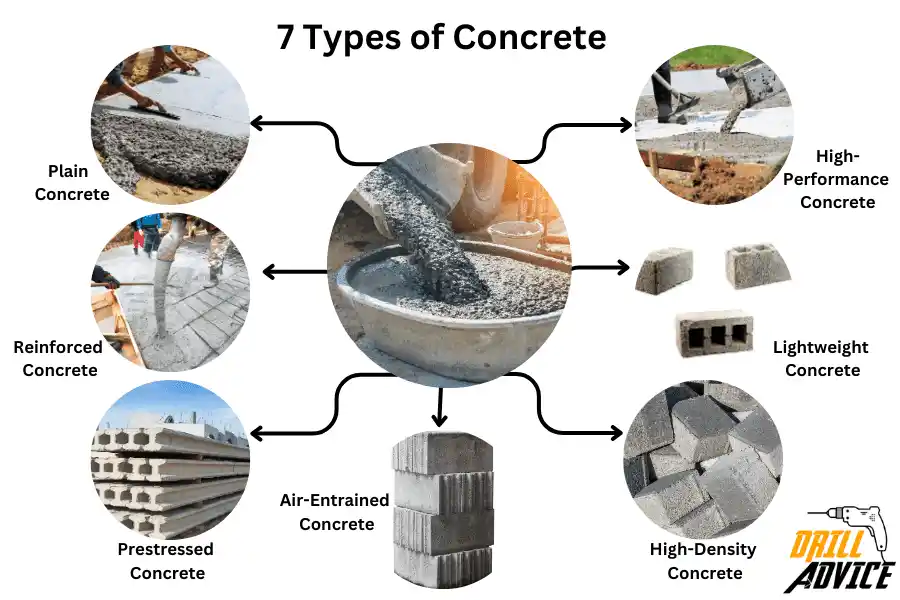
1. Plain or Ordinary Concrete
- Normal Strength Concrete: Strength ranging from 10 MPa (megapascals) to 40 MPa. Used in residential buildings, pavements, and non-structural elements where the stress isn’t high.
- High Strength Concrete: Compressive strength greater than 40 MPa. Used in commercial structures, bridges, and high-rise buildings due to its high compressive strength.
2. Reinforced Concrete
- Reinforce concrete is used to improve the compression area of the reinforcement design. Because reinforcements are weaker in the compressions. Mainly reinforcements are used in beams, columns and slabs. The reinforcement concrete strength typically between 15 and 70 MPa. According to the requirement of compression strength higher grade concrete is used.
3. Prestressed Concrete
- Pre-Tensioned Concrete: Typically have strengths ranging from 30 to 50 MPa, sometimes up to 70 MPa. Used in construction elements like beams, columns, slabs, bridges where high strength and performance are required.
- Post-Tensioned Concrete: Post-Tensioned Concrete: Typical strengths are similar to pre-tensioned concrete, between 30 and 50 MPa.Primarily used in slabs, bridges, and structures requiring high performance and durability.
4. High-Performance Concrete
- Ultra-High Performance Concrete (UHPC): Compressive strengths can be up to 150 MPa and even higher. Used in bridges, nuclear power plants, and anywhere extreme durability and strength are required.
- Self-Consolidating Concrete: Strength varies based on the specific mix but is often similar to traditional concrete, around 30 to 50 MPa. Used in complex shapes of formwork and in areas with congested reinforcement, as it doesn’t require vibration to consolidate.
5. Lightweight Concrete
- Structural Lightweight Concrete: Compressive strength usually ranges between 17 and 34 MPa. Used in precast structural units, framed structures, and in both buildings and bridges.
- Insulating Concrete: Strength is typically low, often below 10 MPa. Used for thermal insulation in walls, roofs, and floor slabs.
6. High-Density Concrete
- Natural Aggregates: Strengths are similar to traditional concrete, between 20 and 40 MPa. Used in the construction of radiation shields and counterweights.
- Synthetic Aggregates: Strengths are generally similar to or higher than traditional concrete, often 30 to 50 MPa. Used in nuclear power plants for radiation shielding.
7. Air-Entrained Concrete
- Normal Air-Entrained Concrete: Strength typically varies between 20 and 40 MPa. Used in outdoor flatwork, such as pavements and sidewalks, particularly in areas with severe freeze-thaw weather conditions.
- High Air Content Concrete: Strength is typically lower due to the high air content, often between 15 and 25 MPa.
- Used in speciality applications requiring high workability and resistance to freeze-thaw cycles.
Read More About – How to Drill into Concrete: 8 Step Guide
What are the Grades of Concrete?
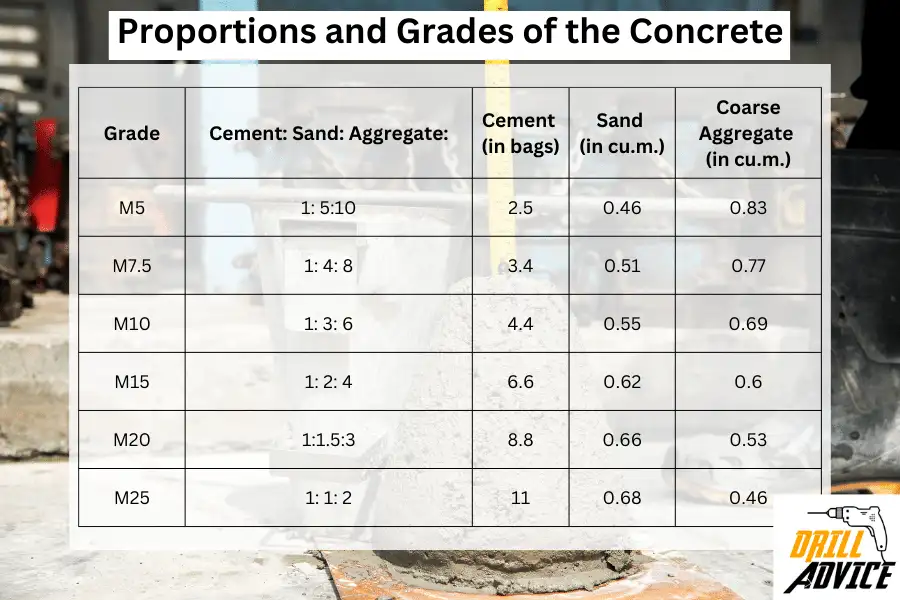
The grade of the concrete is the minimum compressive strength of the concrete achieved after 28 days of pouring. The grade is denoted by M, and the compressive strength is measured by the MPa (Mega Pascal). The concrete grade is varied with cement, sand, and aggregate composition. By using fly ash and admixtures grade can be improved with time.
The main used concrete grade is M20 and M25. Beyond the M30, grades should be designed as a mix design using standard codes.
| Concrete Grade | Compressive Strength (N/mm²) | Typical Application |
|---|---|---|
| M5 | 5 | Used for Mass Concrete in non-structural work like pathways. |
| M7.5 | 7.5 | Ideal for wall constructions, plastering, and tiling work. |
| M10 | 10 | Suitable for PCC (Plain Cement Concrete) e.g., levelling course, bedding for footing. |
| M15 | 15 | Used for reinforced brickwork and floor slabs where the weight isn’t significant. |
| M20 | 20 | Used in the construction of Slabs, Beams, Columns, Footings, etc. |
| M25 | 25 | Generally used for constructing columns and beams. |
| M30 | 30 | Ideal for heavy-duty applications like building foundations. |
| M35 | 35 | Used for heavily reinforced sections of bridges, large raft slabs, etc. |
| M40 | 40 | Used for pre-stressed concrete and for those areas which require very high durability. |
What are the Proportions and Grades of the Concrete?
The proportion of concrete is the ratio of the considered material available in the composition mixture. Proportion is expressed as cement: sand: aggregate ratio. Upto M25, there is no proper water proportion. But more than M25 there is a water-to-cement ratio in the mix design. This is the water-cement ratio. The water amount can reduce when the water-cement ratio is reduced.
The concrete grade is varied with its composition material such as cement, sand, aggregate, fly ash, and admixtures. When these are mixed with different proportions, various grades of concrete can be produced. Grade M5 to M25 can be mixed according to the below proportions. More than M30 should be designed according to the standard engineering codes.
| Grade | Cement: Sand: Aggregate | Cement (in bags) | Sand (in cu.m.) | Coarse Aggregate (in cu.m.) |
|---|---|---|---|---|
| M5 | 1: 5:10 | 2.5 | 0.46 | 0.83 |
| M7.5 | 1: 4: 8 | 3.4 | 0.51 | 0.77 |
| M10 | 1: 3: 6 | 4.4 | 0.55 | 0.69 |
| M15 | 1: 2: 4 | 6.6 | 0.62 | 0.6 |
| M20 | 1:1.5:3 | 8.8 | 0.66 | 0.53 |
| M25 | 1: 1: 2 | 11 | 0.68 | 0.46 |
What are the Compositions of Concrete?
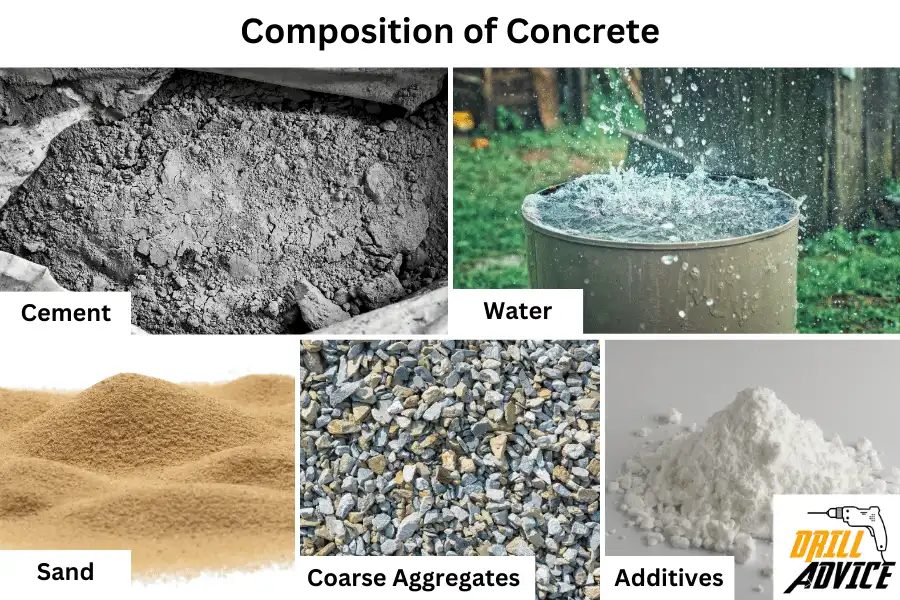
Composition material is defined as the material which was produced by two or more constituent materials. Hence concrete is a composition material consisting of cement, sand and aggregate with additives. Cement act as the bonding agent between the materials. Water can hydrate the paste and improve workability. Sand (fine aggregate) can fill the volumes between coarse aggregate and cement. The coarse aggregate highly resits for compressive strength and additives are used to improve the workability and strength with time.
1. Cement: Often referred to as Portland cement, this element acts as a binding agent when mixed with water. It combines with water to form a paste that envelops the fine and coarse aggregates, eventually hardening and gaining strength to form the rock-like mass known as concrete. Cement’s role is paramount for the hardening and strength development process, making it a critical component of concrete.
2. Water: The water acti mainly in two ways in the concrete. First, it interacts with the cement to form a paste through a process called hydration, causing the concrete to harden. Second, it aids workability, making the concrete mix easy to pour and shape before it sets.
3. Fine Aggregates (Sand): Fine aggregates fill in the small gaps left between the coarse aggregates and the cement paste. This contributes to the concrete’s overall strength and prevents voids in the hardened material. The sand also improves the workability and smoothness of the concrete mix.
4. Coarse Aggregates (Rock or Gravel): These components are the primary filler in the concrete mix. They significantly influence the concrete’s compressive strength and reduce the amount of cement paste needed.
5. Additives: Additives are also included in the composition of concrete. Additives can improve the concrete’s durability, reduce the water requirements, and reduce the curing time. The most used additives are fly ash, slag cement, and silica fume.
Cement for Concrete
Cement is a fine powdered material. Cement is the binding agent for the concrete between coarse aggregate and fine aggregate. Cement consists of 4 main compounds such as tricalcium silicate (3CaO · SiO2), dicalcium silicate (2CaO · SiO2), tricalcium aluminate (3CaO · Al2O3), and a tetra-calcium aluminoferrite (4CaO · Al2O3Fe2O3).
The cement is produced by heating limestone and clay minerals in a kiln by heating between 1300-1450 °C (2372- 2642 °F).
The cement reacts with water. When water is added to cement, it is hydrated and becomes solid material.
According to hydration and usage, cement are mainly 5 different types. Those are
- Ordinary Portland Cement (OPC): This is the most common type of cement, known for its excellent durability and strength.
- Portland Slag Cement (PSC): Made with a blend of clinker and granulated blast-furnace slag, PSC is known for its resistance to chemicals and favourable for use in marine constructions.
- Portland Pozzolana Cement (PPC): Manufactured by blending OPC clinker with pozzolanic materials, PPC is known for its low heat of hydration, making it suitable for mass concreting.
- Quick Setting Cement: As the name suggests, this type of cement sets quickly and is used in underwater construction and cold and rainy weather conditions.
- Low Heat Cement: This type of cement produces less heat during hydration and is used in massive concrete constructions like dams.
Each types of cement have different properties. Before use a cement, its properties should know properly. The most important properties of the cement are fineness, setting time, heat of hydration, soundness, strength, workability, and specific gravity.
- Fineness is the particle size of the cement. It impacts the rate of hydration.
- The setting time of the cement is the amount of time it takes for cement to change from a liquid state to a solid state.
- The heat of hydration is the generated heat from the cement while hydration. This affects to thermal expansion and contraction of the concrete.
- Soundness is the ability of the cement paste to retain its volume after it has hardened.
- Strength is the compressive strength of the concrete after 28 days of pouring.
- Workability determines how easy to mix, place, finish and compact the concrete.
- Specific gravity is the weight of a given volume of material to the weight of an equal volume of water
Aggregates for Concrete
Aggregates are inert granular materials that are mixed with cement and water to create concrete.
Aggregates are used in concrete in order to add volume, reduce concrete, reduce the amount of cement, make concrete more economical, improve the strength of concrete, improve the durability of concrete and control the shrinkage of the concrete.
The aggregate of concrete is mainly two types. Those are fine aggregates and coarse aggregates. Fine aggregates are considered as small particles such as sand and quarry dust. Coarse aggregates are large materials than fine aggregates. The aggregate percentage is 60-80% of the total mixture of the concrete.
The aggregate size is mainly two categories. Those are coarse aggregate and fine aggregate. ‘Coarse aggregate’ is stones or crushed rocks, usually ranging from 3/8 inch to 1.5 inches in size. ‘Fine aggregate’ are sand and usually passes through a 3/8-inch sieve.
The maximum size of coarse aggregate is 1.5 inches for massive structures, such as large building foundations or dams. The common aggregate size is 3/4 inch which is used for general residential constructions.
As for the minimum size, fine aggregate like sand is typically used, which can be as small as 0.15 mm in diameter. The fine aggregate fills up the voids between the coarse aggregate and helps in achieving a denser and stronger concrete mix.
Admixtures for Concrete
Concrete admixtures are materials that are added to the concrete mixture to modify the properties of the concrete. Admixtures are used to improve concrete workability, improve strength, improve durability, control setting time, control water content, control corrosion of reinforcement steel, and reduce shrinkages mainly. Each admixture has a specific task.
There are several types of concrete admixtures, each serving a different purpose. Here’s a table summarizing the most common ones:
| Admixture Type | Task |
|---|---|
| Air-entraining Admixtures | Increases resistance to freeze-thaw degradation |
| Water-reducing Admixtures | Reduces the water requirement for a concrete mix |
| Accelerating Admixtures | Speeds up the rate of concrete setting |
| Retarding Admixtures | Delays the rate of concrete setting |
| Plasticizers (High-range water reducers) | Increases the workability of concrete |
| Superplasticizers | Greatly improves workability and allows for greater flexibility in concrete design |
| Corrosion-inhibiting Admixtures | Slows the corrosion of reinforcing steel |
| Shrinkage Reducing Admixtures | Reduces drying shrinkage and minimizes cracking |
| Alkali-silica reactivity inhibitors | Mitigates deleterious expansion of concrete due to alkali-silica reaction |
| Coloring Admixtures | Adds color to the concrete for aesthetic purposes |
Reinforcement for Concrete
Reinforcement of the concrete provides better tensile strength than conventional concrete. Concrete itself is robust under compression but weak in tension. The reinforcing steel bars carry the tensile loads, making the combination of concrete and steel bars significantly stronger and more versatile than the individual components.
Reinforcement bars, often made of steel, come in different types, sizes, and strengths. They are chosen based on the specific needs of the project. These bars are usually arranged in a grid pattern and tied together with wire before the concrete mix is poured over them. As the concrete hardens, it grips the bars, creating a unified, fortified structure.
The reinforcement ratio in concrete structures is a vital factor. It’s defined as the ratio of the area of the steel reinforcement bars to the total concrete area. The maximum reinforcement ratio for concrete is subject to the type of the concrete, steel, and the specific design of the structure. Over-reinforcing or under-reinforcing can lead to structural problems, hence the reinforcement ratio must be calculated accurately.
What are the Ways to Mix Concrete?
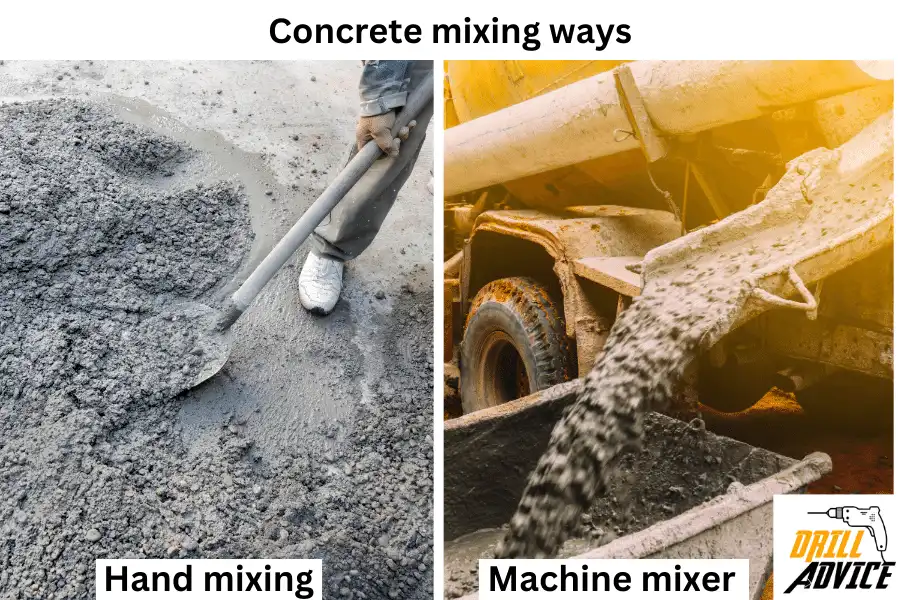
Concrete mixing is an essential step in the process of laying concrete, impacting the overall quality and strength of the end product. There are two primary ways to mix concrete: by hand and using a concrete mixer.
Hand mixing is typically used for smaller projects. It involves combining the concrete components in a wheelbarrow or a mixing tray, using a spade or shovel. The process starts by making a depression in the middle of the dry mix, then adding water. The dry components are gradually folded into the water until a uniform mix is achieved. While this method can be labor-intensive, it allows for precise control over the consistency of the mix. However, the process can be slow and inefficient for larger jobs.
Concrete mixer is suitable for large projects. These machines come in various sizes, from small portable mixers suitable for DIY home projects to large commercial mixers used in construction. The process of mixing with a concrete mixer involves adding the dry components first, followed by the water. The mixer is then turned on, and it automatically mixes the components into a uniform mixture. This method is significantly more efficient and can produce a higher volume of concrete in a shorter time.
How to Calculate Concrete Volume?
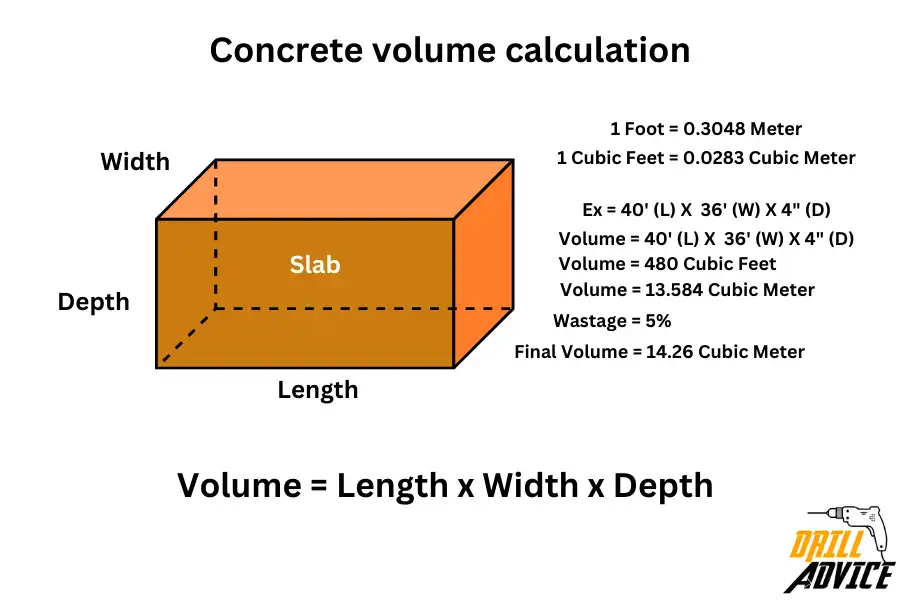
The process of concrete volume calculation is essential in many home improvement projects and is fundamental to ensuring the accurate measurement of materials. This knowledge can help prevent the wastage of resources and unnecessary expenditures. Let’s delve into how this can be achieved.
Calculating the volume of concrete primarily requires the dimensions of the area you are planning to fill with concrete. The volume is generally measured in cubic meters (m³) or cubic feet (ft³), depending on your preferred measurement system.
For simplicity, if we take a rectangular slab as an example, you need to multiply the length, width, and depth (height) of the slab to determine the volume. Here is the formula:
Volume = Length x Width x Depth.
Make sure that all dimensions are in the same units before calculation.
Suppose you plan to pour a concrete slab that is 4 meters long, 3 meters wide, and 0.1 meters deep. Applying the formula,
The volume would be: 4m (Length) x 3m (Width) x 0.1m (Depth) = 1.2 cubic meters of concrete.
However, it is crucial to factor in a certain amount of overage or ‘extra’ to account for variations in the actual project versus the planned one. This can account for errors in measurement, uneven surfaces, or spillage. A common approach is to add an extra 5-10% of concrete to your calculated volume.
In our example, if we consider an extra 10%,
we would need: 1.2m³ x 0.10 (10%) = 0.12m³. So, the total concrete needed would be 1.2m³ + 0.12m³ = 1.32m³
What is a Concrete Mix Design?
Concrete mix design is a procedure to find suitable ingredients of concrete and determine their relative proportions according to the required strength, durability, and workability as economically as possible. The process ensures that the right amount of materials are used, reducing waste and ensuring efficiency.
In terms of standards, the American Concrete Institute (ACI) and the British Standards (BS) are commonly referenced in the process of concrete mix design. Specifically, the ACI 211.1 “Standard Practice for Selecting Proportions for Normal, Heavyweight and Mass Concrete” and BS 8500 “Concrete – Complementary British Standard to BS EN 206” provide essential guidelines.
When considering concrete mix design, there are several factors to be considered. These include the intended use of the concrete, the environmental conditions it will be exposed to, the type and amount of cement to be used, and the properties of the aggregates. Other considerations include workability, strength, durability, and the cost of materials.
If you’re looking for authoritative texts on the subject, the following books are recommended:
“Design and Control of Concrete Mixtures” by Steven H. Kosmatka and William C. Panarese, Beatrix Kerkhoff – This book serves as a comprehensive guide for concrete mix design and provides an in-depth understanding of the characteristics of concrete.
“Concrete Admixtures Handbook: Properties, Science, and Technology” by V.S. Ramachandran – A significant reference for those interested in understanding how various additives influence the properties of the concrete mix.
“Concrete Technology” by Neville & Brooks – This book covers fundamental concepts, including mix design in great detail, and is considered a staple reference in the field of concrete technology.
What is the Strength of Concrete?
Concrete strength is a ability of a concrete structure to withstand loads without deforming or failing. This strength is primarily determined by the amount of water used in the mix, the aggregate’s type and size, and the curing process.
To assess the strength of concrete, several tests are commonly used, two of which are the cube test and the cylinder test. These tests involve casting concrete into specific shapes, allowing it to cure, then applying compressive force until failure occurs. The force required to break the concrete piece provides a measure of its strength.
The cylindrical strength test, often known as the compressive strength test, involves forming a cylindrical specimen of concrete. This is typically done with a diameter of 150 mm and a height of 300 mm. The test measures the concrete’s capacity to resist compressive loads.
On the other hand, the cubic strength test involves forming concrete into a cube, usually with a side length of 150 mm. This test, similar to the cylindrical one, also gauges the concrete’s ability to resist compressive loads.
When comparing cylindrical strength to cubic strength, cube specimens typically yield higher strength values than cylindrical specimens of the same mix, size, and age. This difference is due to the fact that the cube specimen tends to fail along more planes than the cylindrical specimen, which generally leads to higher compressive strength readings.
In terms of when these tests should be carried out, concrete strength is commonly checked at 7 days, 14 days, and 28 days. The 28-day mark is especially significant as it is generally considered the point at which concrete has reached its full strength.
What are the 5 Tests of Concrete?
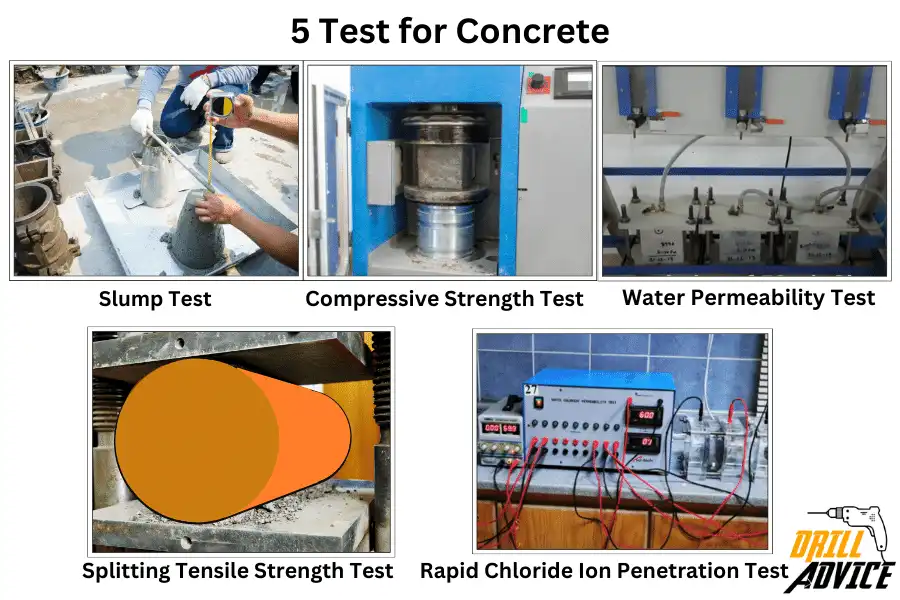
Concrete tests are used to ensure the strength, stability and durability of the structure. Each test has a standard method, specific equipment, and expected results. If the test is passed properly, the tested result should be in the expected result. The most used concrete tests are the slump test, compressive strength test, water permeability test, splitting tensile strength test and rapid chloride ion penetration test.
Slump Test
The first and most common is the slump test. This measures the workability and consistency of fresh concrete. By observing how much a cone of concrete slumps or falls when the cone is lifted, engineers can infer whether the mixture has the right balance of ingredients for the task at hand.
Compressive Strength Test
The compressive strength test checks how much load a concrete sample can bear before breaking. Samples are cast into cubes or cylinders, cured, and then crushed after 7 days, 14 days and 28 days. The result is typically reported in pounds per square inch (PSI), indicating compressive strength.
Water Permeability Test
Water permeability test is essential to understand the water resistance and durability of the concrete. High permeability can lead to issues like corrosion of reinforcement bars, so this test helps prevent future structural problems.
Splitting Tensile Strength Test
The splitting tensile strength test assesses the concrete’s resistance to tensile forces. This is often performed using a cylindrical sample, which is subjected to a load until it breaks.
Rapid Chloride Ion Penetration Test
Rapid Chloride Ion penetration test measures the concrete’s resistance to chloride ion penetration, a common cause of degradation in concrete structures exposed to marine environments or de-icing salts. High levels of chloride can lead to corrosion of the steel reinforcement in concrete, impacting its integrity and longevity.
What Happens When Concrete Fail the Test?
When concrete fails a strength test, it’s often an indication of issues in the concrete mix or curing process. These could range from improper mix proportions, poor quality of ingredients, inadequate curing, or even errors in the testing process itself.
Concrete test are done for 3 samples. If all the samples are failed, concrete can be tested with ultrasonic pulse velocity or rebound hammer tests to assess the in-situ strength of the concrete.
Concrete should be demolished if it fails all the tests.
What is Concrete Curing?
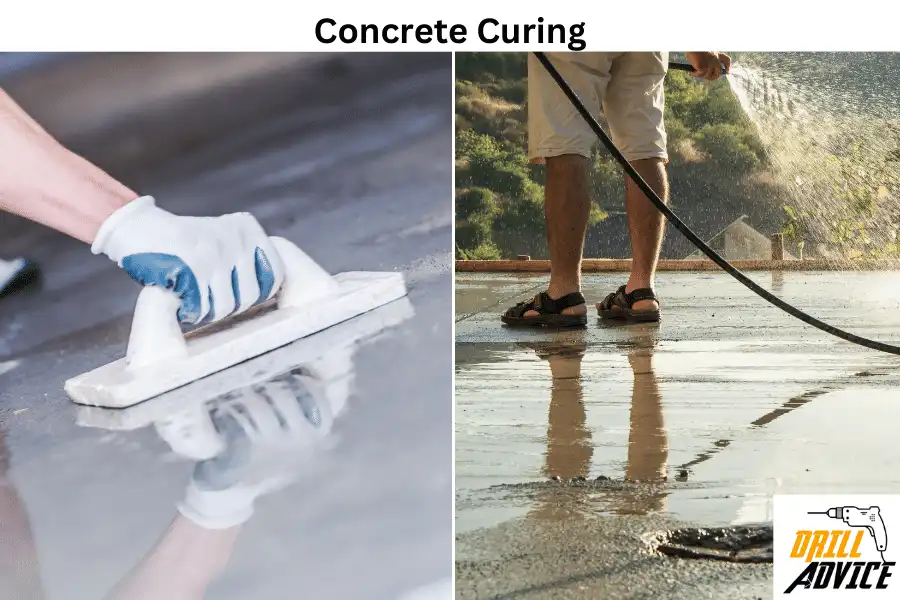
Concrete curing is the procedure of controlling the water content in concrete after it has been poured. The goal is to maintain optimal conditions to allow the concrete to continue to harden over a specific period. This process is necessary because once the concrete is poured and begins to harden, hydration occurs. Hydration is the chemical reaction between water and cement that eventually leads to the hardened concrete we see in structures.
The need for curing arises from the very nature of concrete. If concrete dries too quickly, it can result in reduced strength and increased susceptibility to cracking and shrinkage. To prevent these undesirable outcomes, curing aims to keep the concrete damp and reduce the evaporation rate of water from the concrete.
There are several reputable brands available for those interested in products to aid in the concrete curing process. One of them is “Sika,” renowned for its range of concrete cure compounds. They offer an array of products suitable for different environments and concrete types. Another popular brand in the industry is “W.R. Meadows.” This brand offers curing and sealing compounds that meet the stringent standards of the American Concrete Institute (ACI). “BASF” is another trusted name, providing concrete curing products that are both high quality and environmentally friendly.
What are the Concrete Defects?

Concrete defects are anomalies that compromise concrete structures’ overall integrity, durability, and aesthetics. They range from visible issues like cracks and honeycombing to more subtle ones like efflorescence and pop-outs.
Cracks are the most common concrete defect, primarily due to shrinkage, thermal expansion, and improper curing. Shrinkage occurs as the concrete dries, while thermal expansion happens when concrete is exposed to varying temperature extremes. Honeycombing, another defect, consists of voids within the concrete, attributable to poor consolidation or inadequate compaction during pouring.
If you encounter a concrete defect, the action plan depends on the defect’s nature and severity. Small cracks can often be fixed using epoxy or polyurethane-based concrete sealants. For honeycombing, the defective concrete might need to be removed and replaced, requiring a professional’s expertise.
How to Fix Damaged Concrete?
Concrete damages are primarily visible as cracks, chips, and surface scaling. They occur due to several factors, such as exposure to freeze-thaw cycles, use of de-icing chemicals, inadequate curing, or improper mixing.
So, how can we fix damaged concrete? The answer depends on the severity of the damage.
For smaller cracks, first clean the area, apply a concrete repair mix, smooth it out, and allow it to cure. More severe damage might require the removal and replacement of the affected concrete. If the damage penetrates deep into the concrete structure, it’s wise to call in professional help to ensure a safe and proper repair.
Damaging factors to concrete include the use of low-quality concrete mix, inadequate curing, and exposure to harsh weather conditions. Properly mixing and curing the concrete, along with applying a suitable sealant, can help prevent such damages. Also, during winters, avoiding the use of de-icing salts and chemicals on concrete surfaces can prevent surface scaling.
Is Tile Durable than Concrete?
No, concrete is generally more durable than tile. Concrete is a very strong and durable material that can withstand heavy traffic, impact, and extreme weather conditions. It is also resistant to fire and moisture. Tile, on the other hand, can be quite durable, especially porcelain and ceramic tiles, but they can chip or crack under heavy impact. They are also more likely to suffer damage from extreme weather conditions compared to concrete. Therefore, while high-quality tiles can last for many years with proper care and maintenance, concrete is generally more durable and long-lasting.
History of Concrete?
In 1849 Joseph Aspdin found modern concrete by inventing Portland cement by heating a mixture of limestone and clay, then grinding it into a powder. This power hardened into rock-like mass when it mixed with water. But the evolution of concrete is starting in 25 BC.
- Around 25 BC – Roman architect Vitruvius discussed a mixture that combined volcanic ash, lime, and seawater to form an early type of concrete.
- During Roman Empire (27 BC – 476 CE) – Romans discovered and extensively used a cement mixture involving pozzolans and lime, contributing to numerous architectural feats such as the Colosseum and the Pantheon.
- 1300s – Concrete fell out of widespread use after the fall of the Roman Empire and was rarely used during the Middle Ages.
- 1756 – John Smeaton, an English engineer, developed a modern version of concrete. He used powdered limestone and clay to create hydraulic cement, which could harden underwater.
- 1793 – John Smeaton’s advancements were further improved upon by another British engineer, James Parker, who patented a natural hydraulic cement that he called “Roman Cement”.
- 1824 – Joseph Aspdin, an Englishman, invented Portland cement by heating a mixture of limestone and clay, then grinding it into a powder. When mixed with water, this powder hardened into a rock-like mass, marking the birth of modern concrete.
- 1849 – Joseph Monier, a French gardener, invented reinforced concrete, which included steel mesh or rods to improve the tension of the material.
- 1867 – Joseph Monier presented his invention at the Paris Exposition and received a patent for his invention of reinforced concrete.
- Late 19th – Early 20th Century – The introduction and common use of steel-reinforced concrete revolutionized architectural design and construction.
- 1920s – The development of concrete pumps and other advanced construction equipment made it easier to transport and place concrete at construction sites.
- Early 20th Century – Introduction of precast concrete, which involves casting concrete in a reusable mold or “form” which is then cured in a controlled environment, transported to the construction site, and lifted into place.
